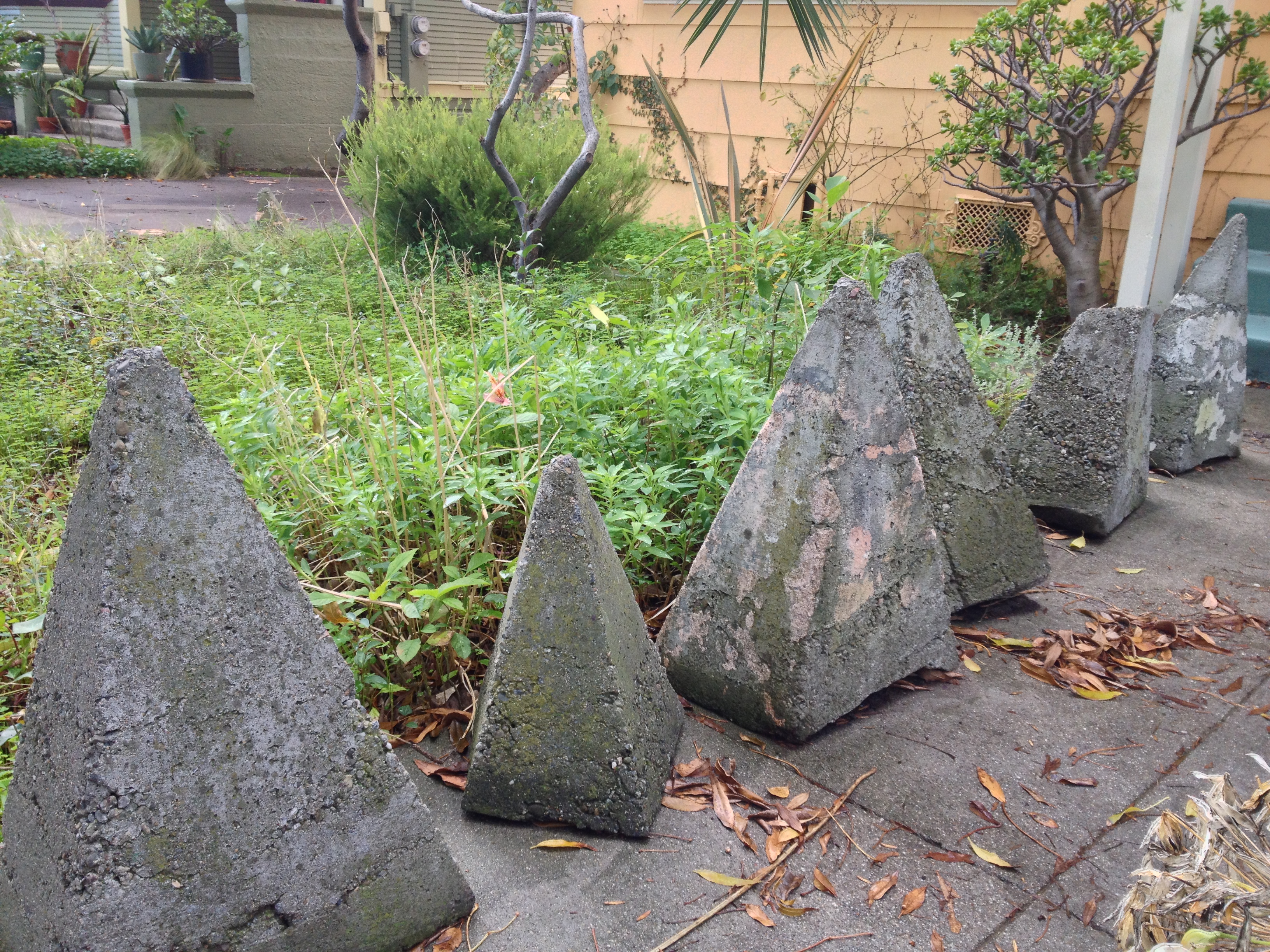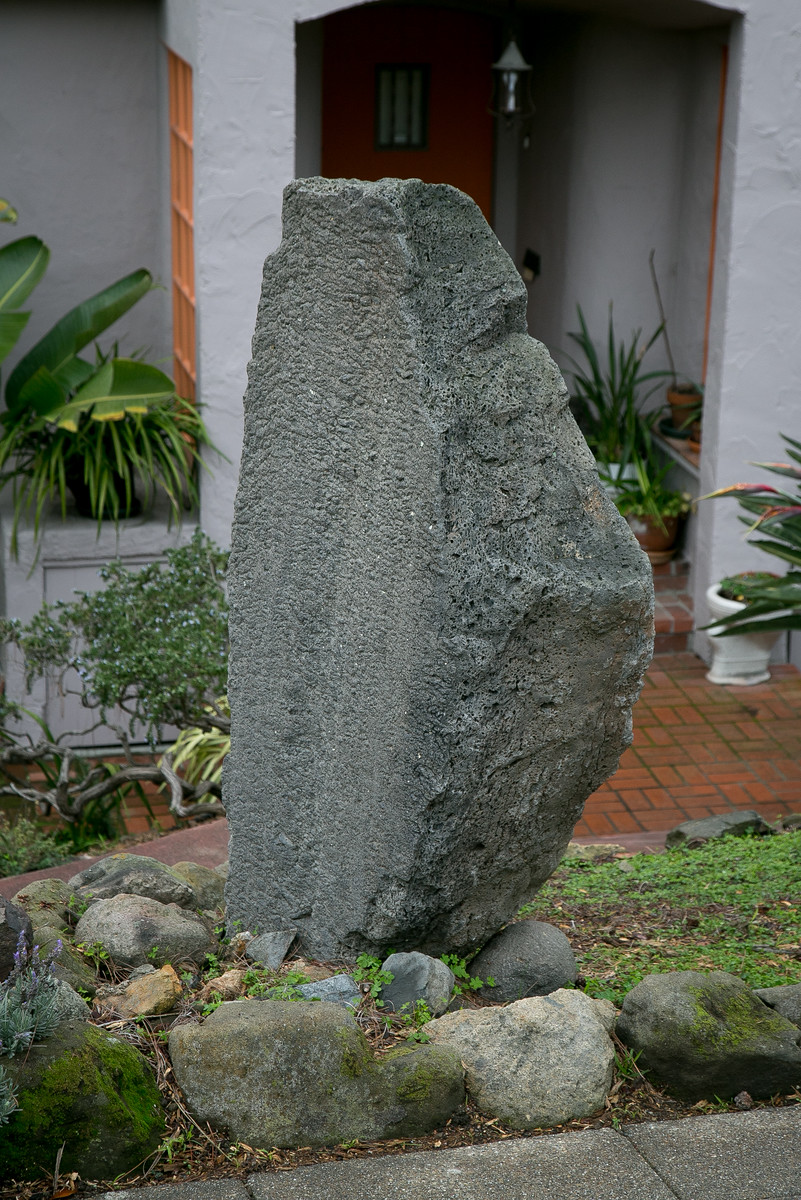I was extremely proud of myself when the title for this post – Berkeley Rocks – came to me. Noun and verb! So clever! No telling where I could have gone with that –
Berkeley swings! Like a pendulum do – hippies on bicycles, two by two.
Berkeley rules!
Berkeley wails!
And that could have led from rocks to stones to stoned:
But –
Not!
But it was not meant to be.
I saw this book and knew – I didn’t think of the pun first! Dang. That’s life though.
Chester’s book is about building around the big rocks that are part of our geology, especially just north of my house on Oxford Street. All about me! This post is not about the same thing. This post is about how we use rocks as decorative features. Like the remnants of a once-elaborate rock grotto on Oakvale shown above.
The hole in this front-yard rock is from its past life in a rock climbing store. The hole to demonstrate aid-climbing apparatus.
I thought that there was a specific name for this type of rock balancing/ stone stacking. I can’t find it though. I find that there are formations made with pure balance, counterbalance, balanced stacking, and free style, but I don’t find the name that I was looking for. Any thoughts on this?
Vanessa Moraga wrote me almost right away with a thought: “Possibly the term you are looking for is “Axial Stones” which I think was perhaps coined by the artist George Quasha. He published a book entitled Axial Stones: An Art of Precarious Balance“. Though I have seen the book I don’t know much about him so… from wikipedia:
George Quasha is an American artist and poet who works across media, exploring a principle in common within language, sculpture, drawing, video, sound and music, installation, and performance. This principle, axiality, he defines as ‘the principle of free-moving order, liminality, and precarious, spontaneous configuration.’ His axial stones are delicately balanced sculptures of two (occasionally three) stones positioned one upon another at the most precarious point discovered. Quasha’s sculptural process, more tactile and body-centered than visual, follows strict rules: specific “found” stones must be felt to attract each other; one stone must find its place on the other at the smallest available point of contact; no adhesive is permissible; and neither stone may be modified in any way. In this context, “axial” refers to the invisible axis that comes into focus at the moment of precarious balance. In addition to axial stones, Quasha has created axial drawings, executed with two hands simultaneously; axial drumming/music, non-metrical pulsation-based rhythm arising from interaction of instruments, sounds, surfaces; and axial poems, discovering points of charged variability in actual language use and bringing about a self-actualizing process.”
Thank you Vanessa. The Quirky Berkeley Nation rocks!
This, I think, approaches being a cairn. If there are any cairn experts in the Quirky Berkeley reading audience, please let me know.
If I am not mistaken, Lowell Bergman lived in this house and commissioned this rock wall/fence.

Al Pacino played the Lowell Bergman figure in The Insider. Here he is making a phone call near the Cheeseboard. When we had pay phones. Can you imagine that – being played by Al Pacino! But, I digress.
This rock was designated to be a fountain in the backyard of the house. But – they couldn’t drill through it for the water line and it would have had to have been craned over the house. So it is not a fountain. It is just a rock – a great one to be sure, but just a rock.
Mark Haggitt made this stone circle. He is all about things Celtic. There are approximately 1,300 stone circles in the British Isles. They have no equivalent elsewhere in Europe. Stonehenge is the best known. Avebury is the largest, then the Stanton Drew stone circles, then the Ring of Brodgar. And then there is this on Peralta.
Do you see my point? About how Berkeley rocks rock?
I showed the draft post to my friend. “I dig the pun – rocks, swings, rules, wails – not. Just so happens – Gabby sent me some ‘what a trip’ stuff.”
I said I’d take a look at it, but what is his take on the Berkeley rocks shown here?











































Hi Tom,
I think the the Bergman rock wall was done by a student of Peter Volkos by the name of Patty Ferber who now resides in L.A……A very cool series, corny as Hell, but very cool never the less.
All the best, Doug
Hi Tom,
That is the house that Lowell Bergman lived in and the wall was built by my ex-husband Zhdan Rudnyckyj and Patty Ferber. I lived in that house briefly with Lowell’s wife Sharon and our four kids (two of hers, two of mine). Those rocks by the gate could be turned, or spun around.
Onward,
Robbin
There are a lot of stone walls along the Arlington that have been built by old time stone masons, just as the walls were built in England or Scotland, etc. Check it out.